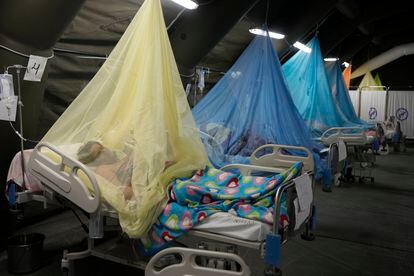Peru declares health emergency in 20 regions after 32 dengue deaths

Since the nineties, the dengue virus has been a hidden threat to Peruvians. But, as with other disasters, it usually takes the state by surprise, acting against the clock when the situation has already escalated. After a worrying 2023 in which 18 deaths and 12,264 infections were caused by Aedes aegypti mosquitoes, experts have given clear advice on what to do to prevent similar damage to public health. These include prevention measures, procurement of medicines, communication strategies, improved infrastructure, training of specialists, as well as increasing public access to drinking water, since mosquitoes are known to lay eggs in stagnant waters. However, the authorities’ response was again late.
On February 5, as cases surged and nearly a dozen deaths were reported, Health Minister Cesar Vázquez Sánchez denied it was an epidemic and believed that declaring an emergency was not yet necessary. Three weeks later, the government reversed course and accepted the crisis, declaring a state of emergency in 20 regions for 90 days. More Peruvians have died from dengue in just two months than in all of 2023: 32 confirmed deaths, to be added by eight more cases under investigation, and a further 31,364 infections. According to statistics, if we take into account the same time period, the increase compared to 2023 is 97%.
“Lima is not yet in an epidemic situation, but we cannot wait for an unstable situation to arise. That is why, instead of declaring a state of emergency in the five regions where the largest number of cases have been reported, we decided to move on to the 20 that are in immediate danger and where the infection could increase,” justified Minister Vázquez, now committing himself to prevention. Until seventh week, according to the National Center for Epidemiology, Prevention and Control of Diseases, the regions where the virus has spread the most are: La Libertad (4207), Piura (4155), Ica (3313), Ancash (2462), San Martin ( 1633) and Lima (1495).

The comparison with the prevalence in previous years over the same time period is alarming: for example, in the coastal region of Libertad, only fourteen cases have been reported so far in 2023. There were only three infected in Ancash, and twenty in Lima. two. The forecasts are not at all reassuring. And the Minister of Health himself could not hide this: “March and April will be much stronger,” he said briefly about the growth of the infection curve.
Adding context to the health deficiencies is the weather conditions, the ovens that cities have become, and the intense rainfall due to El Niño. As temperatures rise, the regiment of adult mosquitoes expands for a reason: their development, which previously took a week, is now pronounced: on average, it takes three days. It must be emphasized that there are regions where drinking water is scarce and buckets and other containers are commonly used which, if not properly maintained, end up becoming a source of dengue fever. According to the National Sanitation Services Authority (Sunass), 3.3 million Peruvians still do not have a public drinking water network, and 6.4 million do not have a sewer connection.
For infectious disease specialist Juan Carlos Celis, the most important thing is to provide hospital treatment, not fumigation. “Everything is written. The problem is the force and speed with which it is being done. It is too late for a fumigation campaign. What is needed is full-fledged dengue control units: 12 beds, 5 doctors, 5 nurses and 10 technicians. All trained. For thirty hospitalized patients, at least two full teams. Unfortunately, history repeats itself,” he notes.
Three of the four known dengue serotypes are currently circulating in Peru: DENV-1, DENV-2 and DENV-3. As you know, the most common symptoms of dengue fever are fever, muscle pain, rash, dehydration and headaches. If timely treatment is not started, the clinical picture may become more complex and lead to damage to vital organs. In addition to the trigger effect on the nervous system, as well as the blood system (significant decrease in platelets).
Until the sixth week of 2024, Peru had the highest death rate in South America and the third highest in the entire continent: 0.1167, just below Panama (0.1916) and Honduras (0.1411), according to the Pan American Health Organization. Today, despite the fact that the party is against it, the Ministry of Health intends to correct the situation through training and negotiations on how to identify and eradicate mosquito breeding sites.
Follow all information from El PAÍS America in Facebook And Xor in our weekly newsletter.